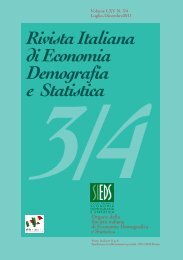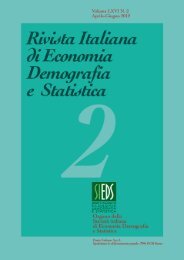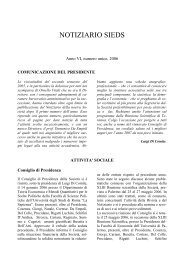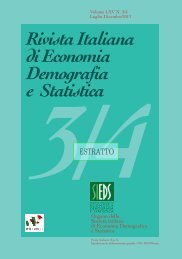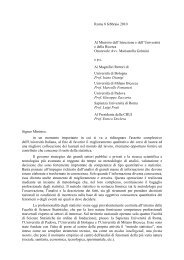rivista italiana di economia demografia e statistica - Sieds
rivista italiana di economia demografia e statistica - Sieds
rivista italiana di economia demografia e statistica - Sieds
You also want an ePaper? Increase the reach of your titles
YUMPU automatically turns print PDFs into web optimized ePapers that Google loves.
38<br />
Volume LXIII nn. 3-4 – Luglio-Dicembre 2009<br />
References<br />
[1] Deaton, A. (1985), Panel data from time series of cross sections, Journal of<br />
Econometrics, 30, 109-126.<br />
[2] Gunatilaka, R. and Chotikapanic, D. (2006), Inequality trends and determinants in Sri-<br />
Lanka: a Shapley Approach to decomposition, Working paper 6/06, Department of<br />
Econometrics and Business Statistics, Monash University.<br />
[3] Shapley, L. 1953. A value for n-person games, in H.W.Kuhn and A.W.Tucker, eds.<br />
Contributions to the theory of games, vol. 2 (Princeton University Press).<br />
[4] Shorrocks, A.F. 1982. Inequality decomposition by factor components. Econometrica,<br />
vol. 52, pp. 1369-1385.<br />
[5] Shorrocks, A.F., 1999. Decomposition Procedures for <strong>di</strong>stributional analysis: a unified<br />
framework based on the Shapley value. Mimeo, University of Essex.<br />
[6] Verbeek, M., and Nijman, T. (1992), Can cohort data be treated as genuine panel<br />
data?, Empirical Economics, 17, 9-23.<br />
SUMMARY<br />
Inequality in Italy: an approach based on the Shapley value decomposition<br />
The aim of this paper is to analyse inequality in Italy between 1997 and 2004.<br />
We decompose the Gini index of inequality using the Shapley value decomposition<br />
(Shapley, 1953; Shorrocks, 1982) in order to rank the contribution of <strong>di</strong>fferent<br />
socio - economic variables to income inequality among in<strong>di</strong>viduals and time.<br />
Shapley's value decomposition is a regression based technique that allows to<br />
consider <strong>di</strong>fferent explanatory factors, both economics and demographics. We used<br />
data from the Italian Household Budget Survey (ISTAT) in the period 1997 - 2004,<br />
previously treated in order to group in<strong>di</strong>viduals in cohorts with the aim to<br />
understand the dynamic of <strong>di</strong>fferent factors contribution to inequality, using a<br />
Pseudo - Panel approach.<br />
________________________<br />
Martina CELIDONI, PhD student in Economics and Management, University of<br />
Padua.<br />
Margherita GEROLIMETTO, Lecturer in Economics Statistics, University of<br />
Venice.<br />
Luca SALMASI, PhD student in Economics and Finance, University of Verona.



